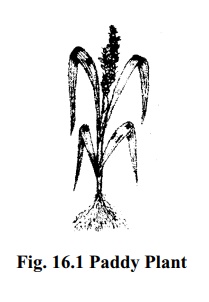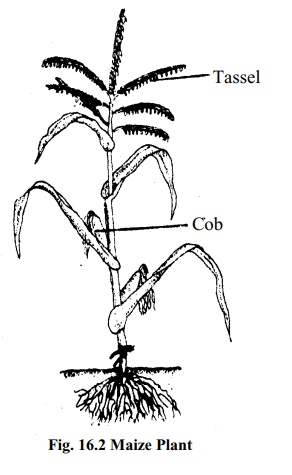Chapter: Biology: Economic Biology (Botany)
Food producing plants
Food producing plants:
Food gives us energy to work,
fulfils the decaying of body and adds nutrition to our body. According to
nature of nutrient compounds, human foods are divided into six categories. They
are: l. Carbohydrates, 2. Protein, 3. Fats, 4. Mineral salts, 5. Vitamins and
6.Water. Every category of food contains some amount of water. Short
introductions of 10 food-producing plants are stated here.
1.
Paddy (Oryza sativa):Paddy is a grass likeplant. The stem is hollow, leaves are
elongated and with leaf sheath. Panicle of paddy grows at the apex of the stem.
in Bangladesh three varieties of rice are cultivated - a) Aus (sown in Feb -
April), b) Amon (sown in wet soil during June-July), c) Boro (sown in low land
during . Nov.-Jan).Besides these high yielding varieties of IRRI and BRRI paddy
also cultivated. IRRI and BRRI varieties of paddy may be sown as Aus, Amon or
Boro.
Uses:
We get rice from paddy and boiled
rice is our staple food. From paddywe also get flattened rice (Chira) and
Puffed rice (Muri).

2.
Wheat (Triticum sp):Like paddy wheat is also a grass in nature. The plantattains
a height of 2-3 ft. Wheat plant also bears apical inflorescence.
Uses:
We get Suji, Aata, (course flour),
and Moida (flour) fromwheat. in many countries (cold countries) wheat is the
staple food.
3.
Maize or Corn (Zea mays):Maize is an annual monocot plant. It
attains a height of 3-6 feet. Its stem is solid and from the lower part of the
stem there develops stilt roots. The plant producestwo types of inflorescence
- the male inflorescence is called tassel and the female inflorescence is
called Cob.Uses: Corn grains are
eaten afterroasting in fire, from corn grains cornflakes, corn oil, corn flour
etc. are made. Corn oil cantains very less amount of cholesterol and it is good
for our health. In many countries (mexico) corn is the staple food.

4.
Potato (Solanum tuberosum):Potato plant is a small herb in nature. stem issoft, leaves
are compound. Tip of the underground portion of stem becomes swollen and
produces the potato tuber. In our country potatoes are used as vegetables, but
it is the staple food in many countries like Ireland. Wheat, Rice Maize,
Potatoes, these are all carbohydrate food.
The following table (Table-16.1)
shows a comparative statement of the amount (in 100 grams) of Carbohydrate,
Protein and Fat in Rice, Wheat, Maize and Potatoes.

5. Lentils (Lens esculanta):Lentils (Mosoor) is an
annual winter crops. Leavesare compound, leaflet slender, elongated, and many in number per leaf.
Flowers are Papilionaceous. Fruits are flat pod It is used in every day's menu
as dal.
6. Gram or chickepe a (Cicer arietinum):Chipckpea is a winter
crop. Stem attains aheight of 1-2 feet. Leaves are pinately compound. Leaflet
semicircular, margin dented, flower papilionaceous.
7. Groundnut (Arachis hypogea):Groundnut plant is an
annual, small herb.Leaves are compound, imparipinnate. Flowers grow on the soil
surface on the aerial part of the
plant but after pollination
it thrusts. into
the soil. Thus the fruit develops
under the surface of the Soil. Lentils, gram, groundnut etc. are proteinaceous
food because they contain much protein. Ground may also be nut called oily
food.
The following
table (table 16.2)
shows a comparative
statement of the amount (in 100 grams) of Protein, Fat and
Carbohydrates in Lentils, Gram and Groundnut

8. Mango (Mangifrera indica):Mango plant is a big
tree. Its leaves are simple,elongated and alternate. Flowers grow in
inflorescence. Fruits ripen in summer. Mango is said to be the king of fruits.
Mango plant grows from seeds; again it can be grown by grafting or layering.
The fleshy mesocarp of the fruit is eaten.
9. Banana
(Musa sp.):The stem of Banana plants lies near the soil surface. It
iscalled rhizome. Aerial part develops from the rhizome. The aerial part of the
plant is actually a compactly arranged leaf bases. It is not a true stem.
Banana grows throughout the year. New plants grow from the suckers. The whole
fruit except the outer covering is eaten. In many countries Banana is the
staple food. Banana may compensate iron deficiency in our body.
10.
Jackfruit (Artocarpus heterophyllus):Jackfruit plant is a big tree.
Leavesare simple, alternate, and more or less obovate. The fruit is complex and
large. Plant grows from seeds. The edible parts of jackfruit are fleshy.
Bracts, perianth and seeds. In addition to carbohydrates, fat and protein, we
get mineral salts and vitamins from fruits like mango, banana and jackfruit.
The following table (Table - 16.3)
shows a comparative statement of different constituents (in 100 gm.) of food in
mango, banana and jackfruit.

Related Topics